Premium Only Content

Walking through Tijuca Forest in Rio de Janeiro - PART 1
Walking through Tijuca Forest in Rio de Janeiro - Christ the Redeemer
Tijuca National Park is claimed to be the world's largest urban forest, covering some 39.58 square kilometres (15.28 sq mi), although this title is disputed with Johannesburg, South Africa.
The park shares its name with the bairros (neighborhoods) of Tijuca and Barra da Tijuca nearby. The word Tijuca comes from the Tupi language and means marsh, a reference to the Tijuca Lagoon in the contemporary Barra da Tijuca.
It is located in a mountainous region which encompasses the Tijuca Massif. Among its impressive peaks are the Pedra da Gávea and Corcovado. The forest and mountains form a natural boundary that separates the West Zone of Rio from the rest of the city, as well as dividing the North and South Zones.
One favela exists in the Tijuca Forest, called Mata Machado. Its inhabitants are mainly the descendants of those who migrated to the region in the 1930s to take part in the replanting effort. Though conditions have improved recently under the Favela-Bairro Project, it still contributes to environmental degradation in the forest.
Ecology
The Forest is home to hundreds of species of plants and wildlife, many threatened by extinction, and found only in the Atlantic Forest biome. The vegetation is so dense that scientists have estimated that ambient temperatures in surrounding areas have been lowered by up to 9 °C. The forest also contains some 30 waterfalls.
-
 LIVE
LIVE
The Quartering
2 hours agoTrump Trying To Stop WW3, Americans Evacuated, Passenger Jet Crashes 240 People Gone & More
8,852 watching -
 LIVE
LIVE
Roseanne Barr
1 hour agoHow To Win The Culture War W/ Ami Kozak | The Roseanne Barr Podcast #103
1,284 watching -
 LIVE
LIVE
StoneMountain64
3 minutes agoTHE absolutely BEST Stream Sniper | Stream Sniper SHOWDOWN
6 watching -
 2:13:58
2:13:58
Tucker Carlson
1 day agoJeffrey Sachs: Ukraine/Russia Dangerous New Escalation, & the Dark Forces Pushing for War With Iran
82.7K143 -
 LIVE
LIVE
LFA TV
15 hours agoLFA TV ALL DAY STREAM - THURSDAY 6/12/25
2,243 watching -
 1:10:43
1:10:43
WTFLeagues
1 hour agoWTF Leagues Live
1.87K1 -
 LIVE
LIVE
Akademiks
4 hours agoDiddy Trial Day 22: Jane Doe aka 50 Cent Baby Moms Cross Examine. ALLSTAR FREEKOFF Day 4/30
2,162 watching -
 1:25:54
1:25:54
Russell Brand
3 hours agoWatch With Us: MK Ultra – CIA Mind Control Exposed - SF596
83K29 -
 LIVE
LIVE
Tommy's Podcast
14 hours agoEstrogen Based Warfare | E.M. Burlingame & Tom Luongo (TPC #1,765)
649 watching -
 11:45
11:45
IsaacButterfield
10 hours ago $0.19 earnedThe Project Is CANCELLED! The New Black Panther Is WHITE and Comedian Jailed for 8 YEARS
9801